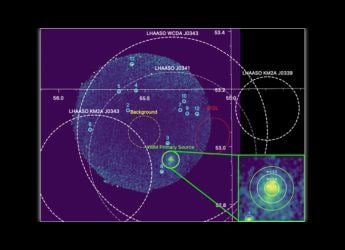- Home
- Science
- Science News
- Rising Satellite Traffic in Low Earth Orbit Sparks Collision Risk Concerns
Rising Satellite Traffic in Low Earth Orbit Sparks Collision Risk Concerns
A study in Acta Astronautica finds that collision-avoidance maneuvers in Low Earth Orbit have increased sevenfold since 2019.

Photo Credit: SpaceX
SpaceX’s Starlink satellites await deployment in Earth’s orbit.
The Low Earth orbit (LEO) is gradually turning into a highway of satellites and a recent study gives serious warnings to the operators and scientists in space. The study indicates that now satellites must perform collision-avoidance maneuvers more often than ever before, and it is now being called into question whether a large and densely crowded orbital regions are sustainable or safe. The query is: does our near-Earth space atmosphere approach an edge?
Rising Collision Risk
According to a study published in the October issue of the journal Acta Astronautica, between 2019 and early 2025, the share of satellites executing more than ten collision-avoidance maneuvers per month jumped from 0.2 % to 1.4 %, which corresponds to approximately 340 spacecrafts that are routinely performing collision-avoidance maneuvers.
By 2019, approximately 13,700 of LEO (at altitudes below the region of 2,000 km) were cataloged, but by 2025 it had increased to 24,185 objects - a 76 percent increase. It is estimated that the number can increase to 70,000 at the end of the decade, more than five times higher than that of 2019. Areas of altitude of 400-600km and 700-800km are already experiencing noticeable congestion which means that satellites have to manoeuvre over ten times a month.
Implications and Possible Paths Forward
Regular moves put a strain on fuel supply, further complicate the planning of missions, and open the prospect of making errors that might increase the risks of collisions. A severe collision would give rise to new debris, which would cause additional avoidance requirements in a domino manner. The paper proposes more coordinated launches - not into the same orbital slots - and the synchronization of orbital orbits by coordination of the operator.
Get your daily dose of tech news, reviews, and insights, in under 80 characters on Gadgets 360 Turbo. Connect with fellow tech lovers on our Forum. Follow us on X, Facebook, WhatsApp, Threads and Google News for instant updates. Catch all the action on our YouTube channel.
Related Stories
- Samsung Galaxy Unpacked 2025
- ChatGPT
- Redmi Note 14 Pro+
- iPhone 16
- Apple Vision Pro
- Oneplus 12
- OnePlus Nord CE 3 Lite 5G
- iPhone 13
- Xiaomi 14 Pro
- Oppo Find N3
- Tecno Spark Go (2023)
- Realme V30
- Best Phones Under 25000
- Samsung Galaxy S24 Series
- Cryptocurrency
- iQoo 12
- Samsung Galaxy S24 Ultra
- Giottus
- Samsung Galaxy Z Flip 5
- Apple 'Scary Fast'
- Housefull 5
- GoPro Hero 12 Black Review
- Invincible Season 2
- JioGlass
- HD Ready TV
- Laptop Under 50000
- Smartwatch Under 10000
- Latest Mobile Phones
- Compare Phones
- Poco F8 Ultra
- Poco F8 Pro
- Huawei Mate 80 RS Master Edition
- Huawei Mate 80 Pro Max
- Huawei Mate 80 Pro
- Huawei Mate 80
- Huawei Mate X7
- Honor 500
- Asus ProArt P16
- MacBook Pro 14-inch (M5, 2025)
- Poco Pad M1
- Poco Pad X1
- Honor Watch X5
- Huawei Watch Ultimate 2
- Acerpure Nitro Z Series 100-inch QLED TV
- Samsung 43 Inch LED Ultra HD (4K) Smart TV (UA43UE81AFULXL)
- Asus ROG Ally
- Nintendo Switch Lite
- Haier 1.6 Ton 5 Star Inverter Split AC (HSU19G-MZAID5BN-INV)
- Haier 1.6 Ton 5 Star Inverter Split AC (HSU19G-MZAIM5BN-INV)

















